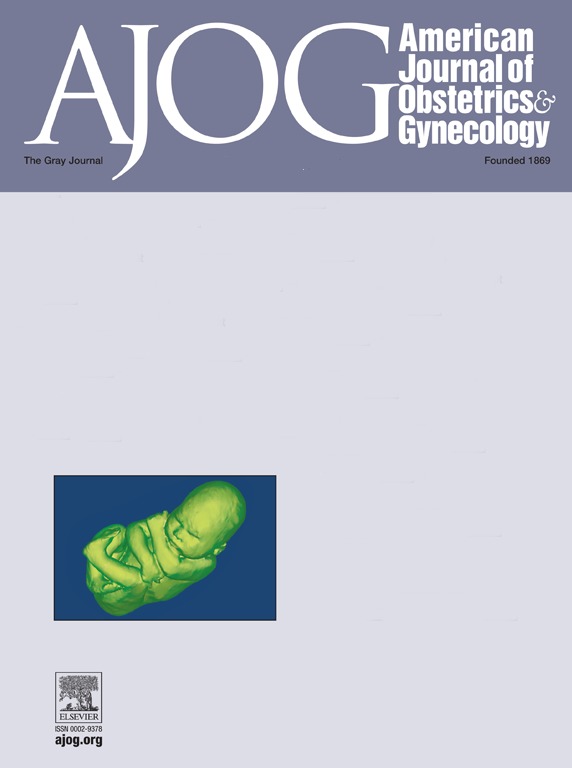Evaluating the clinical utility and strategy of whole exome sequencing testing for fetuses with increased nuchal translucency.
IF 8.7
1区 医学
Q1 OBSTETRICS & GYNECOLOGY
引用次数: 0
Abstract
OBJECTIVE The routine recommendation for detecting monogenic disease in fetuses with increased nuchal translucency (NT) remains controversial. This study aimed to evaluate the clinical significance and optimal strategy of whole exome sequencing (WES) in fetuses with increased NT. STUDY DESIGN This retrospective study included pregnancies that underwent amniocentesis due to advanced maternal age, positive screening results, or abnormal ultrasound findings between January 2018 and December 2019. Chromosomal abnormalities were diagnosed using chromosome microarray analysis (CMA). WES testing was sequentially performed in fetuses with NT ≥ 3.5 mm. Newborns were followed up regularly until they reached 48-60 months of age. RESULTS Of 11,774 pregnancies undergoing amniocentesis, 607 fetuses (5.16%) had NT ≥ 3 mm. Chromosomal abnormalities were detected in 23.56% (143/607), including aneuploidy (13.18%, 80/607) and chromosome deletion/duplication or regions of homozygosity (10.38%, 63/607). The diagnostic yield of CMA for aneuploidies and pathogenic/likely pathogenic (P/LP) chromosome abnormalities was 17.63% (107/607), after excluding 36 cases with variants of uncertain significance (VUS). Among 464 fetuses with NT ≥ 3 mm and negative CMA results, 240 cases had fetal NT ≥ 3.5 mm, of which 96 cases underwent WES testing. WES identified diagnostic variants in genes associated with an increased NT phenotype in 10.42% (10/96) of cases. These variants involved genes of DDX3X, RIT1, NIPBL, ANKRD11, PIEZO2, NF1, ASXL1, CCDC22, and TUBB3, which are inherited in either an X-linked (XL) or autosomal dominant (AD) pattern. Adverse outcomes were observed in 80% (8/10) of these cases, including four induced abortions, three cases of developmental delay, and one neonatal death. A total of 86 fetuses (14.17%, 86/607) had additional ultrasound findings. Fetuses with NT ≥ 3.5 mm and additional ultrasound findings identified during the second trimester exhibited a significantly higher rate of chromosomal abnormalities compared to those without additional findings (44.62% vs. 19.00%, P = 0.00). Among fetuses with NT ≥ 3 mm and negative CMA and/or WES testing results, 90.39% (395/437, after excluding 27 pregnancies lost to follow-up) were healthy during follow-up. The remaining approximately 10% (42 cases) experienced miscarriage, induced abortion, intrauterine fetal death, or developmental delay. CONCLUSION CMA identified chromosomal abnormalities in 17.63% of fetuses with NT ≥ 3 mm. Fetuses with increased NT and additional ultrasound findings exhibited a significantly higher rate of chromosomal abnormalities. WES provided an additional diagnostic yield of 10.42% for monogenic disorders in fetuses with NT ≥ 3.5 mm. WES testing, combined with data reanalysis based on subsequent prenatal/postnatal phenotypes, offers an optimal strategy for diagnosing monogenic diseases in fetuses with increased NT.评估全外显子组测序检测胎儿颈部透明度增加的临床应用和策略。
目的:在颈透明(NT)增加的胎儿中检测单基因疾病的常规建议仍存在争议。本研究旨在评估全外显子组测序(WES)在nt增高胎儿中的临床意义和最佳策略。研究设计本回顾性研究包括2018年1月至2019年12月期间因高龄、筛查结果阳性或超声异常而进行羊膜穿刺术的妊娠。采用染色体微阵列分析(CMA)诊断染色体异常。对NT≥3.5 mm的胎儿依次进行WES检测。新生儿定期随访,直到他们达到48-60个月大。结果11774例行羊膜穿刺术的孕妇中,NT≥3mm的有607例(5.16%)。染色体异常占23.56%(143/607),其中非整倍体占13.18%(80/607),染色体缺失/重复或纯合区占10.38%(63/607)。在排除36例不确定意义变异(VUS)后,CMA对非整倍体和致病性/可能致病性(P/LP)染色体异常的诊断率为17.63%(107/607)。在464例NT≥3mm且CMA阴性的胎儿中,240例胎儿NT≥3.5 mm,其中96例进行了WES检测。WES在10.42%(10/96)的病例中发现了与NT表型增加相关的诊断基因变异。这些变异涉及DDX3X、RIT1、NIPBL、ANKRD11、PIEZO2、NF1、ASXL1、CCDC22和TUBB3基因,这些基因以x连锁(XL)或常染色体显性(AD)模式遗传。这些病例中有80%(8/10)出现不良后果,包括4例人工流产、3例发育迟缓和1例新生儿死亡。共有86例胎儿(14.17%,86/607)有额外的超声发现。在妊娠中期发现NT≥3.5 mm并有其他超声检查结果的胎儿,其染色体异常发生率明显高于无其他超声检查结果的胎儿(44.62% vs. 19.00%, P = 0.00)。在NT≥3 mm且CMA和/或WES检测结果阴性的胎儿中,90.39%(395/437,剔除27例失访妊娠后)在随访期间健康。其余约10%(42例)经历了流产、人工流产、宫内胎儿死亡或发育迟缓。结论在NT≥3 mm的胎儿中,有17.63%的胎儿存在染色体异常。有NT增加和其他超声检查结果的胎儿表现出染色体异常的明显更高的比率。对于NT≥3.5 mm胎儿的单基因疾病,WES的额外诊断率为10.42%。WES检测结合基于随后产前/产后表型的数据再分析,为诊断NT增高胎儿的单基因疾病提供了最佳策略。
本文章由计算机程序翻译,如有差异,请以英文原文为准。
求助全文
约1分钟内获得全文
求助全文
来源期刊
CiteScore
15.90
自引率
7.10%
发文量
2237
审稿时长
47 days
期刊介绍:
The American Journal of Obstetrics and Gynecology, known as "The Gray Journal," covers the entire spectrum of Obstetrics and Gynecology. It aims to publish original research (clinical and translational), reviews, opinions, video clips, podcasts, and interviews that contribute to understanding health and disease and have the potential to impact the practice of women's healthcare.
Focus Areas:
Diagnosis, Treatment, Prediction, and Prevention: The journal focuses on research related to the diagnosis, treatment, prediction, and prevention of obstetrical and gynecological disorders.
Biology of Reproduction: AJOG publishes work on the biology of reproduction, including studies on reproductive physiology and mechanisms of obstetrical and gynecological diseases.
Content Types:
Original Research: Clinical and translational research articles.
Reviews: Comprehensive reviews providing insights into various aspects of obstetrics and gynecology.
Opinions: Perspectives and opinions on important topics in the field.
Multimedia Content: Video clips, podcasts, and interviews.
Peer Review Process:
All submissions undergo a rigorous peer review process to ensure quality and relevance to the field of obstetrics and gynecology.

 求助内容:
求助内容: 应助结果提醒方式:
应助结果提醒方式:


